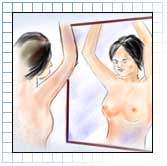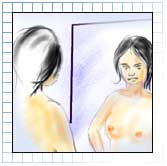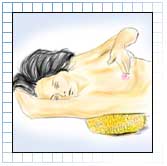| |
Why should one do
BSE?
There is a 1 in 10 chance that a woman will have
breast cancer during her lifetime. Over 1,000,000
women find lumps in their breasts every year some of
which are cancerous but most are benign. A simple
Breast Self-Examination (BSE) can be the key to
finding any abnormality early. |
| |
Who should do BSE?
It is good to be in the habit of breast
self-examination (BSE) on a regular basis since
early detection leads to early investigation and
treatment. Women of all ages should perform
self-examination since breast problems can occur at
any age. The best time of the month to perform
self-examination is after menstruation, when the
breast tissue is softer and lumps are more likely to
be felt. Immediately prior to menstruation the
breast becomes naturally lumpy and often tender -
features that can mask a problem. For women who are
post-menstrual, with irregular periods or who have
had hysterectomy, a suitable time should be chosen -
for example the 1st day of the month. Examination
more frequently than this, is probably not necessary
and may lead to increased anxiety. A woman who
regularly examines her breasts will get a very clear
idea of her normal breast texture and consistency,
and will help her to notice if something is
different. Individual hospitals and specialists may
advise slightly different methods, but the
principles of BSE are the same. |
| |
How to do BSE?
There are two basic steps to conducting a BSE:
1. Visual Examination
2. Tactile Examination |
| |
Visual Examination
During the first part of the BSE, the visual
examination, you look for changes in each breast.
What is important in visual BSE is not the normal
difference between your two breasts, but any change
in one breast without a similar change in the other.
The changes you have to look for include: |
| |
* Shape
* Size
* Contour or symmetry (is there a difference in the
level between your nipples? Do both breasts look
symmetrical?)
* Skin discoloration or dimpling
* Bumps/lumps – NOTE: normal lumpiness, like in the
week before and of your menstrual cycle, will appear
as very small and separate lumps like the texture of
an orange.
* Sores or scaly skin
* Discharge or puckering of the nipple
* Dimple
* Ulceration |
| |
| Stand in front of a mirror and look
for the above changes in your breasts (from both a
frontal and profile view) in 3 different positions: |
| |
 |
 |
|
With your arms
raised |
With your arms down at your sides
|
|
Bending forward
1. with your hands on your hips and shoulders turned
in
2. with your arms relaxed hanging in front of you
|
| |
Tactile Examination
This is the part of the examination when you need to
feel your breasts for any changes. It is important
to check the surrounding areas because breast cancer
may be found in the lymph node tissue around the
breast and underarm. Begin by lying in bed. Place a
small pillow or folded towel under your left
shoulder and your left hand behind your head. Your
shoulder should be raised high enough for your left
breast to be center on top of your chest, falling
neither to the center nor toward the armpit; this
arrangement distributes the breast tissue as evenly
as possible across the chest wall. If a breast is
not properly flattened against the chest, it is
difficult to feel a lump – particularly in the outer
upper quadrant, where tissue is thickest (and where
most cancers occur).Feel your breasts and
surrounding areas, which include:
* the breast
* between the breast and underarm
* the underarm
* the area above the breast up to the collarbone and
across to your shoulder
Use the pads (where your fingerprints are) of your
three middle fingers on your right hand pressed
together flat to check your left breast, and do the
opposite for the right breast. You should press on
your breast with varying degrees of pressure:
# light (move the skin without moving the tissue
underneath)
# medium (midway into the tissue)
# hard (down to the ribs "on the verge of pain")
When using any of the 3 patterns, you should always
be using a circular rubbing motion without lifting
your fingers. |
| |
|
 |
| |
Patterns of breast
examination
Spiral: Begin with a large circle around
the perimeter of your breast and make smaller
and smaller circles as you work your way toward
the nipple. |
| |
|
|
| |
| Wedges: Pretend your
breast is divided into sections like triangular
pieces of a cake, begin in the nipple area and
feel your breast in a small circular motion
within one section, then move on to the next
wedge starting in the nipple area again. |
| |
|
|
| |
|
| Vertical or linear: Pretend
your breast is divided into vertical stripes. Begin
on the underarm area on one side and feel your
breast in a small circular motion up and down in a
zig zag pattern till the whole breast is covered.
Then repeat the process for the right breast with
your left hand. |
| |
|
|
| |
What to feel for?
Carefully notice the "feel" of your normal breast
structure, so that you can note at once any changes
from what is usual for you. Many women have a normal
thickening or ridge of firm tissue under the lower
curve of the breast, at its attachment to the chest
wall; also the large milk ducts can be felt as a
ring of bumps at the outer edge of the areola. In
very slender women, the bony prominences of the
chest wall may be mistaken for chest tumours, as may
enlarged milk glands, fat tumours, lymph nodes, or
benign cysts. All such thickenings should be felt
carefully during each monthly BSE, in order to
distinguish normal conditions from potentially
dangerous changes. Any lump or other change found in
one breast only (especially in the upper outer
quadrant) is more likely to be serious. If in doubt
about ANY development, consult your doctor. |
| |


